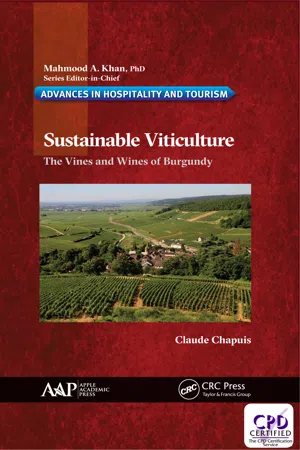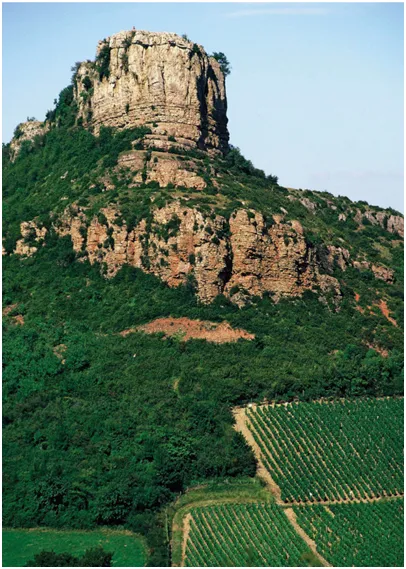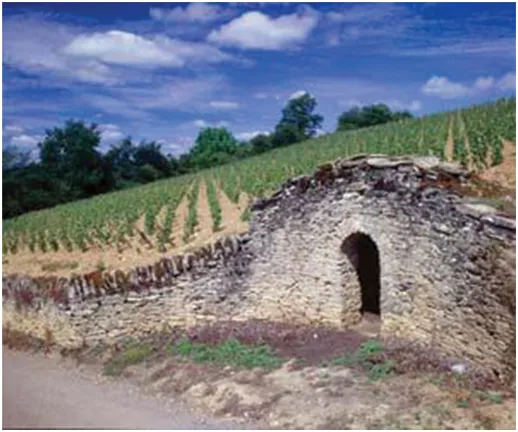![]()
CONTENTS
List of Abbreviations
Preface
Acknowledgments
1. Wine and Culture
2. Wine and History
3. Wine and the City
4. The Winegrower’s World
5. Coping with the Challenges of Viticulture
6. Beyond Burgundy
7. Factors of quality
8. Burgundy’s Art of Living
9. Envoy: The Usa and Burgundy, The Wine of Friendship
References
Glossary
Index
![]()
LIST OF ABBREVIATIONS
| BGO | Bourgogne Grand Ordinaire |
| BiVB | Interprofessional Office of the wines of Burgundy |
| ENA | National School of Administration |
| ESC | Burgundy School of Business |
| GMO | genetically modified organism |
| INAO | National Institute of Appellations of Origin |
| INRA | National Research Institute of Agronomy |
| IWO | International Vine and Wine Office |
| OIV | World Organization of Wine |
| PGI | Protected Geographical Indication |
| TGV | high speed train |
![]()
PREFACE
At a very early age, I started working in the vineyard with my brother. Our father never asked us whether we liked it or not. We would have much preferred to play soccer with our friends in the village but we had no choice. Thus, we grudgingly carried out the chores adults were reluctant to do because of their aching back: pulling and burning the canes workers had pruned in winter, tying canes to the lower wire of the vineyard, and removing the suckers in spring. However, trimming the vines with shears in summer was fun and we wouldn’t have wanted to miss the grape harvest in the fall because of the joyful company of casual workers. Indeed, we would have liked to play truant from school but my parents had too much respect for education to allow us to skip classes. We really found it hard to listen to the learned teacher and focus on grammar, arithmetic or history when we saw out of the windows cartloads of grapes being taken to the press or heard cheerful teams of pickers sing and laugh in the street near the school building.
It was hard for a winegrower to make a decent living in the 1950s and the early 1960s. Parents pressured their children to obtain good results at school and at University because they wanted them to become doctors, engineers, or teachers. They thought there was no future for viticulture. The idea prevailed that vineyard work was for underachievers and even losers.
When I received a grant to study literature at a university in Wisconsin, I had the feeling that I was running away from Europe and its old parapets. I thoroughly enjoyed my time in the Middle West but I missed Burgundy a little during the time of the grape harvest. Still, the USA was a land of adventure for me, and like my favorite author, Jack London, I went to the Klondike and Alaska, panned for gold and found none, lived in a log cabin, plied the Yukon River and did all kinds of odd jobs to survive.
In the fall of 1978, in California, near San Francisco, I bumped into an American friend who had studied viticulture and enology in Beaune. He told me: “why do you bother to move furniture or wash dishes? You’d be better off harvesting grapes in the winery where I work.” Thus, at the age of 30, I renewed my interest in viticulture. But in all my American years, I had suspected without admitting it that my moral and spiritual roots were in Burgundy’s wine country.
When I settled back in France, I realized that viticulture was also a real adventure, a 2000-year adventure with its ups and downs, an epic story. The oldest vineyard discovered by archeologists dates back to the first century A.D. By the third century, Burgundy wines were already famous in the Roman Empire. Burgundy was a powerful state in the 15th century, which was also a golden age for its viticulture.
Although they are proud of the glorious past of their province, the inhabitants despise arrogance, they value common sense as well as a sense of duty. They have always enjoyed eating and drinking but they also worked hard and respected the rules imposed by an often rebellious nature. They characterize themselves by their joy of living, a hardy bent, love for their homeland and respect of their terroirs. They have developed an original wine culture which, to outsiders, may sometimes appear to be hard to understand. Burgundy’s viticulture, based on the strong tradition of “local, loyal and steady customs,” in other words the teachings of its history, is in constant evolution. It has proven its ability to adapt to modern times remarkably without losing its soul.
I realized what a rich experience my father had had. He had no opportunity to travel, and yet, he was much wiser and more knowledgeable than me. I decided to write a book about his life as a winegrower. From then on, the interest I took in my homeland, its people, its history and its culture never waned. Although I have tried to understand Burgundy’s wine culture for nearly 40 years, I am certain that many aspects still need to be discovered. This book may be incomplete, yet it is a sincere account of what I have learnt about my native province and its people over the years.
![]()
ACKNOWLEDGMENTS
I wish to thank the Bureau Interprofessionnel des Vins de Bourgogne (BIVB) (https://www.bourgogne-wines.com) and the photographers for the use of several photos in this book.
Special thanks also to Philip Bastable and Peter Stone for carefully re-reading the text.
![]()
CHAPTER 1
WINE AND CULTURE
CONTENTS
1.1 Let Us Set the Scene
1.2 The Spirit of Faith
1.3 The Weight Of Tradition
1.4 Philosophers in the Vineyard
1.5 The Old and the New
1.6 Gleaning on the Vines
1.1 LET US SET THE SCENE
1.1.1 TERROIR AND ITS MYSTERY
Terroir, first of all. For geologist Robert Lautel, this word, which has no translation in other languages, means the soil considered from the point of view of viticulture. In Burgundy, it is the outcome of a long process which started millions of years ago. In the Triassic and Jurassic eras, the toing and froing of shallow seas left the clayey and chalky sediments which are the subsoil of the Cote. Thirty million years before Christ, the upheaval of the Alps created a long strip of land separating Bresse from the Morvan and the Burgundy plateaux. A succession of hillsides appeared along each fault line, followed by the erosion of the upper part and the transport of material toward the lower part.
The East-facing slopes are protected against the rain-bearing SouthWest winds. Early in the morning, they are warmed by the rising sun. Their height varies from 200 to 300 meters, (600-900 feet) and their slope favors the drainage of rain water whilst offering optimal sunshine.
Burgundy is the northernmost great red wine-producing region in the world. Its poor clay, marl, and limestone soils would give very mediocre harvests if cereals or vegetables were grown in them, but with viticulture, soil poverty means wealth. The roots of the vines seek the nutriments, they cannot find on the surface deep down in the subsoil.
Admittedly, vines occupy but a small area, about 1500 hectares, (3750 acres) for the Cote de Nuits and twice as much for the Cote de Beaune. Those who doubt it need only look at a satellite photograph: they will have to concentrate hard to make out the vine slopes. The Cote de Nuits with a fairly marked profile produces well-structured wines which age well. In the Cote de Beaune, the vine area is wider and, at places, resembles a quiet sea. The clay and marl soils give red wines which have a nice bouquet and are both well-structured and smooth. The best vineyards are located in the middle of the hills, where the slope is fairly gentle.
That the variety of soils influences wine quality is a well-known fact. However, it would be impossible to create a mathematical model of growths. All the analyses that have been carried out only bring the beginning of an explanation. The reasons for the quality of Burgundy wine remain a mystery.
The two-thousand-year alliance between nature and man has brought fruit from barren soil and the noblest of products from those fruit. Winegrowers have managed to adapt grape varieties to the terroir. Pinot noir and chardonnay are in perfect harmony with the middle and upper Jurassic soils of the Cote d’Or. The vineyards which wrap themselves around the hills and roll on the tawny earth, the dry stone walls, the maze of trails vigorously express man’s work: the viticultural landscape radiates with labor and order. Thanks to their obstinate work on the soil, their fight against erosion, the adoption of an appropriate trellising system, of terroir- and cultivar-compatible rootstocks, winegrowers have proved to be strong, skilful, and clever.
Like their ancestors, winegrowers of today still work to the rhythm of seasons which govern the vegetative cycle of the vine: the winter sleep, the rise of sap in spring, flowering in summer, and maturing in the fall. Loyal men and women, they are fully aware of the permanence of the work to be done and labor hard to bring the best from their terroir.
1.1.2 SAVE THE VINEYARD CABINS!
The little stone houses called cabottes, scattered all over the vine area, are not specifically typical of Burgundy. They draw on the rural architecture which is common to many regions of France. Thus, they don’t significantly differ from the bories of Vaucluse. The cadoles of the Combe a la Serpent park, in Dijon, are as similar to the cabottes of the Cote d’Or as two peas in a pod.
These small dry stone huts provided shelter to winegrowers in a thunderstorm or when they had a snack, or else they served as tool sheds. Their unsophisticated fittings consisted of stone benches, a hole to let the smoke escape, and openings sometimes adorned with dripstones.
In all likelihood, they were built by winegrowers who had some rudimentary knowledge of the building trade in a time when they had to do many things by themselves. For a long time, mixed farming prevailed, and winegrowers were almost self-sufficient. At that time, women wove hemp, and men built, which, incidentally was rather natural in a region where chalky stones were plentiful. Every village had quarries, and place names such as Les Perrieres (stone quarries in ancient French) and Les Lavieres (not volcanic lava but flat stone deposits) were common in Burgundy. Huts, however, were built with the stones removed from the ground when the growers planted vines.
Even though these little houses are not always well maintained, they must be considered an integral part of our viticultural heritage. Too often, they are overgrown with scrub and brambles. Alas! In their desire to farm every square meter of viticultural land, some winegrowers have taken it upon themselves to demolish them.
Nowadays, t...


